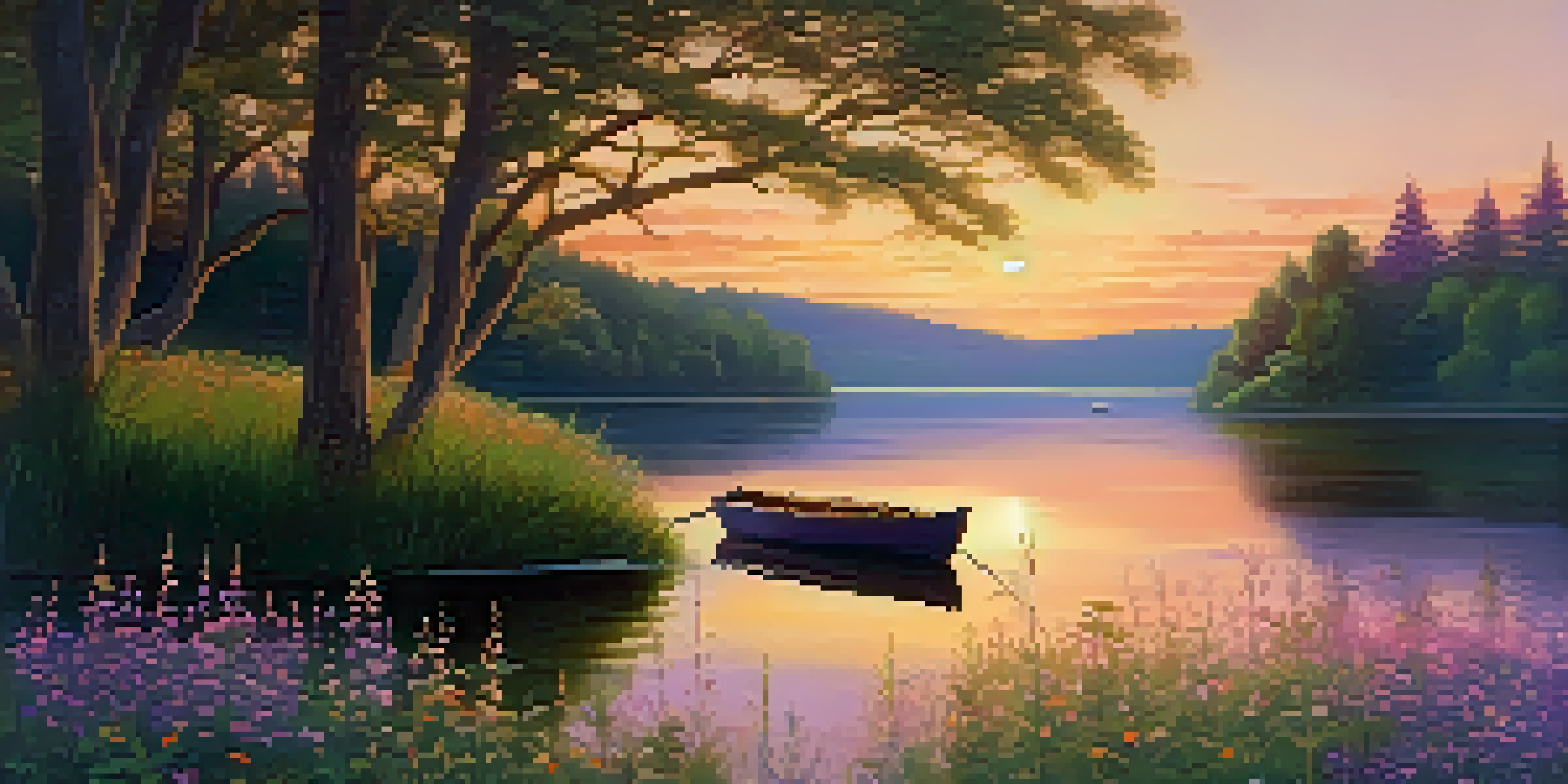How Landscape Painting Reflects Cultural and Personal Identity

The Intersection of Landscape and Identity in Art
Landscape painting serves as a mirror reflecting the identity of both the artist and the culture they belong to. Through natural scenes, artists often express their personal experiences, emotional states, and cultural backgrounds. This connection between art and identity creates a rich narrative that goes beyond mere aesthetics.
Art is the most beautiful of all lies; it can capture the essence of a moment, a place, and a feeling, serving as a reflection of identity and culture.
For instance, consider how an artist from a bustling urban environment might depict landscapes starkly different from those of a rural artist. Each painting can tell stories of longing, belonging, or nostalgia, revealing layers of identity that are deeply personal and culturally significant.
Ultimately, landscape art becomes a canvas for exploring not only the beauty of nature but also the nuanced identities of those who inhabit these spaces. It becomes a shared experience, inviting viewers to connect with both the artist's vision and their own sense of place.
Cultural Influences in Landscape Painting
Different cultures have unique relationships with the land, and this is vividly captured in their landscape paintings. For example, Indigenous artists often incorporate spiritual beliefs and ancestral connections to the land into their work, showcasing a profound sense of identity and history. This reflects how deeply culture shapes the way landscapes are perceived and portrayed.

In contrast, Western landscape painting has evolved from romanticized depictions of nature to more abstract interpretations. This shift mirrors cultural changes and attitudes toward nature, illustrating how societal values influence artistic expression.
Art Reflects Identity and Culture
Landscape painting serves as a mirror for both the artist's identity and the cultural context they represent.
By examining these cultural influences, we can see how landscape painting serves as a documentation of a society's evolving identity. Each brushstroke can reveal the collective consciousness of a culture and its relationship with the environment.
Personal Narratives Embedded in Landscape Art
Artists often infuse their personal stories into landscape paintings, making them reflections of their own lives. A painting of a serene lakeside may evoke memories of childhood summers spent with family, thus carrying layers of personal significance. These narratives transform the artwork into a deeply intimate expression of identity.
The landscape is a message, a visual expression of the culture that created it, revealing the values and identities that shape our understanding of the world.
For example, an artist who has moved away from their hometown might paint landscapes that evoke feelings of nostalgia and longing, using colors and compositions that resonate with their memories. This personal touch invites viewers to not only appreciate the beauty of the scene but to also connect with the artist's journey.
Through these personal narratives, landscape paintings become more than just representations of a place; they tell stories of who we are, where we've been, and how we connect with the world around us.
Nature as a Reflection of Cultural Values
The way landscapes are depicted often reflects the values and beliefs of a culture regarding nature. In cultures that prioritize harmony with the environment, landscape paintings may depict serene, untouched scenes that celebrate the beauty of the natural world. This contrasts with cultures that emphasize industry and urbanization, where landscapes might be portrayed as bustling cityscapes.
For instance, Japanese landscape painting often emphasizes simplicity and the beauty of nature through elements like cherry blossoms and mountains, illustrating a cultural appreciation for transience and natural beauty. This approach offers insight into how cultural perspectives shape artistic representation.
Cultural Values Shape Landscapes
The depiction of landscapes often reveals the underlying values and beliefs of a culture regarding nature and the environment.
By analyzing these differences, we can understand how landscape painting serves as a cultural commentary, revealing the underlying values that influence how a society interacts with its environment.
The Evolution of Landscape Painting Through History
Landscape painting has undergone significant transformations throughout history, often reflecting the cultural shifts of each era. From the idealized landscapes of the Renaissance to the impressionistic styles of the 19th century, each movement reveals a changing relationship with nature and identity. These changes are not merely artistic but represent broader societal trends and values.
For example, the Romantic era emphasized emotional responses to nature, which mirrored the tumultuous social changes of the time. Artists like Caspar David Friedrich used dramatic landscapes to convey feelings of awe and introspection, reflecting a burgeoning individualism.
Thus, landscape painting serves as a historical record of cultural identity, revealing how our relationship with the environment has evolved and transformed over time.
The Role of Landscape Painting in Contemporary Society
In today's world, landscape painting continues to evolve, addressing contemporary issues such as climate change and urbanization. Artists are now using their work to comment on the impact of human activity on the environment, reflecting a growing awareness of ecological concerns. This shift illustrates how landscape painting adapts to the cultural zeitgeist, remaining relevant and poignant.
For instance, modern artists may depict landscapes that show both the beauty and destruction of nature, inviting viewers to reflect on their own relationship with the environment. This duality highlights the tension between progress and preservation, further intertwining personal and cultural identity.
Personal Narratives in Landscape Art
Artists embed their personal stories in landscape paintings, creating intimate connections between the artwork and the viewer's own experiences.
By engaging with these themes, contemporary landscape painting invites viewers to reconsider their identity in relation to the world, ultimately fostering a deeper connection to both nature and society.
Transformative Power of Landscape Painting on Personal Identity
Engaging with landscape painting can be a transformative experience, allowing viewers to explore their own identities through art. As individuals connect with a painting, they may find reflections of their own experiences, memories, and emotions in the depicted landscapes. This interaction can lead to a deeper understanding of self and place.
For instance, someone who grew up near mountains might feel a profound sense of nostalgia when viewing a painting of a similar landscape. Such connections can evoke feelings of belonging and identity, reminding us of our roots and the environments that shape us.

In this way, landscape painting acts as a bridge between the artist's intent and the viewer's interpretation, creating a shared space for personal and cultural reflection. It demonstrates the power of art to resonate deeply within us, influencing our understanding of who we are.